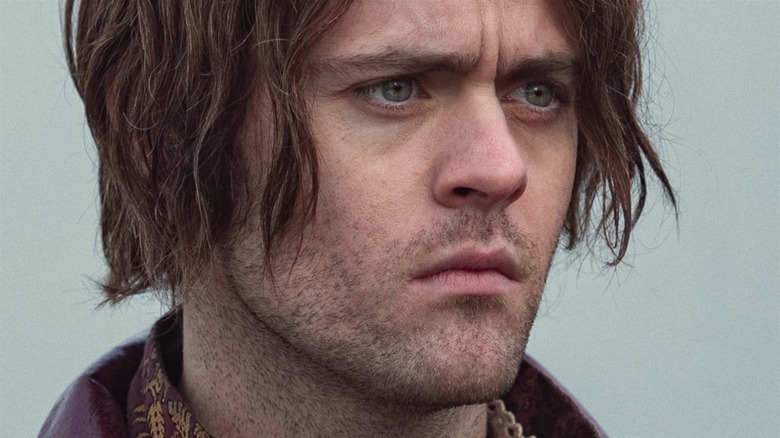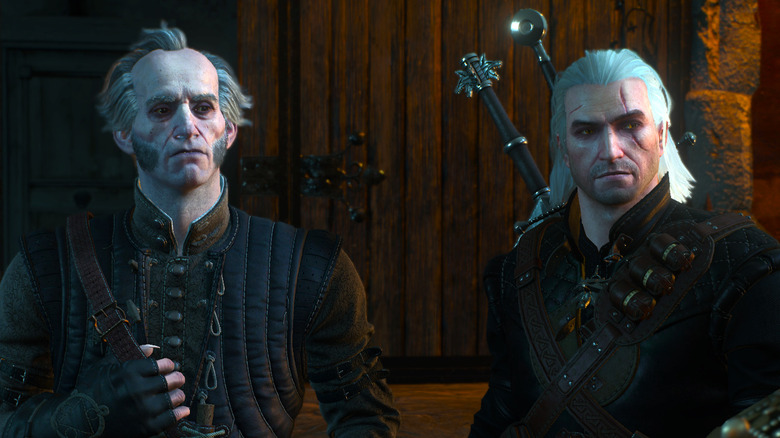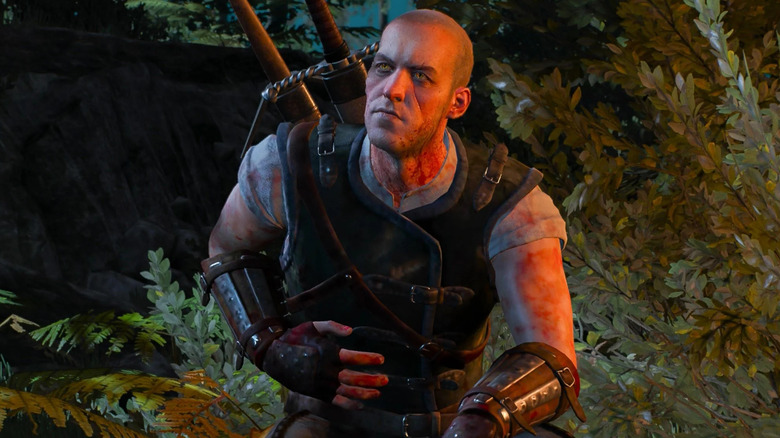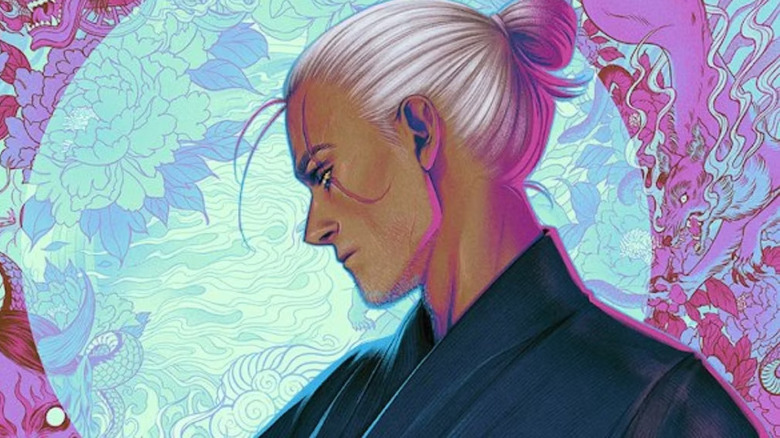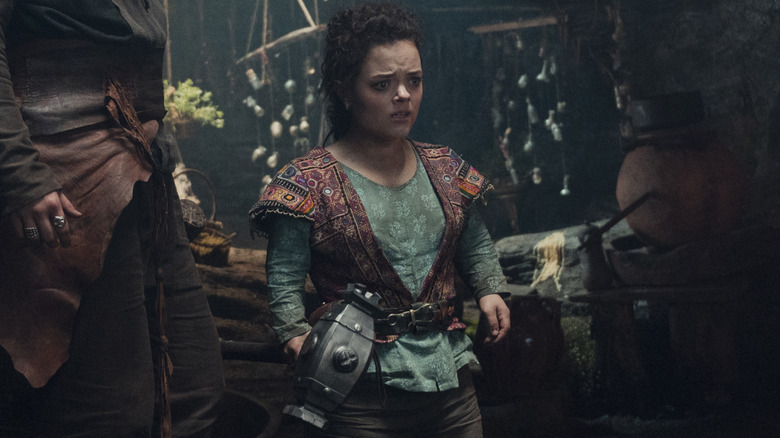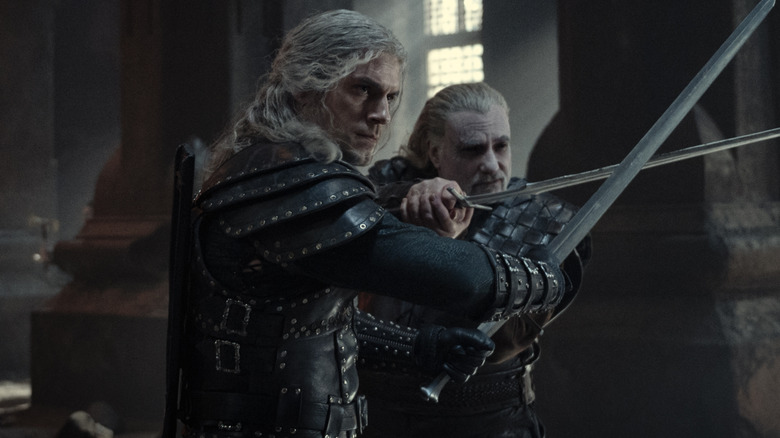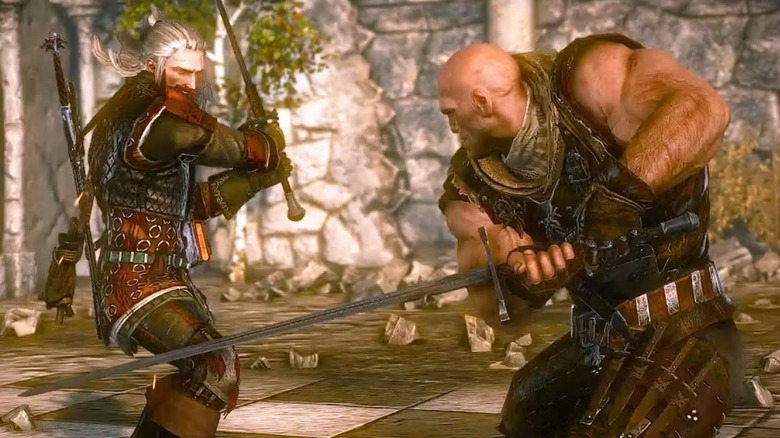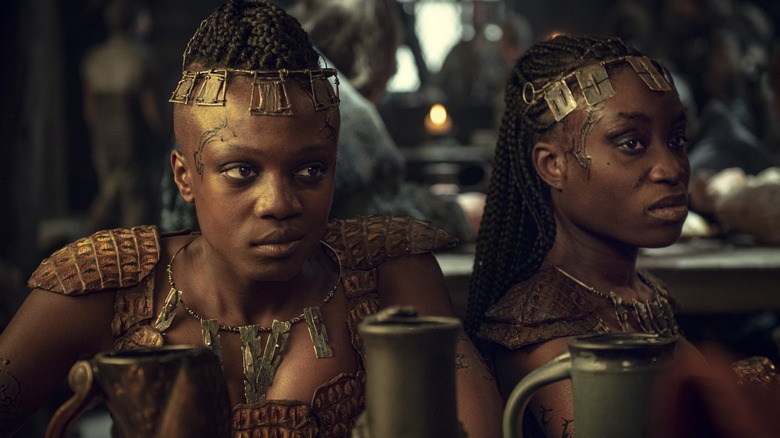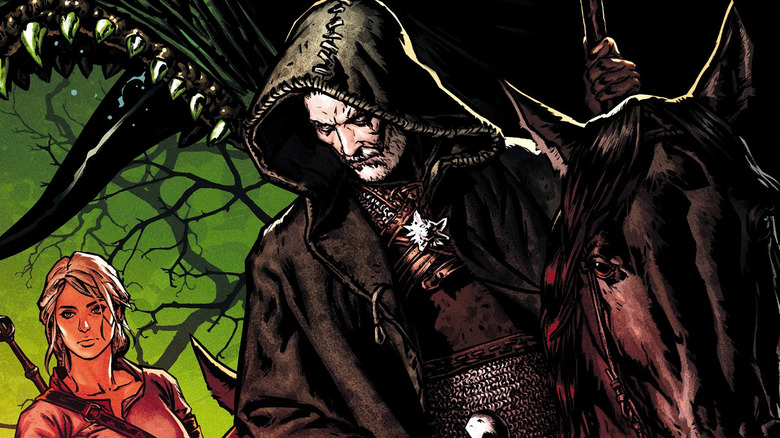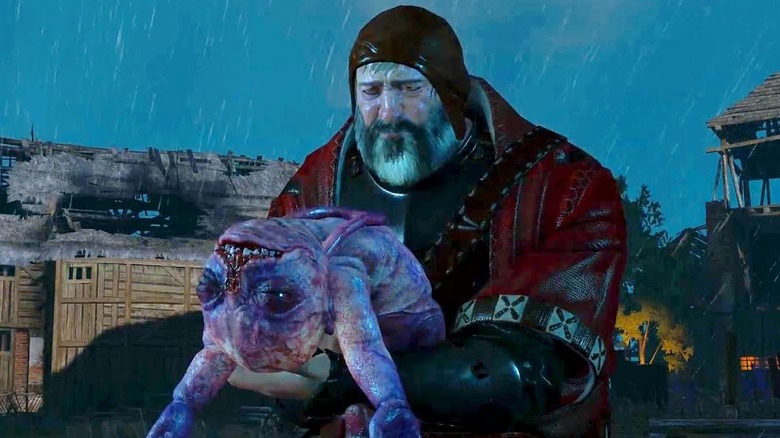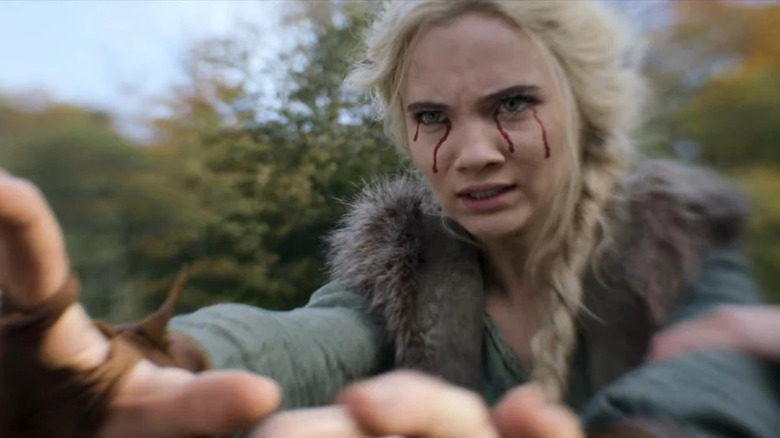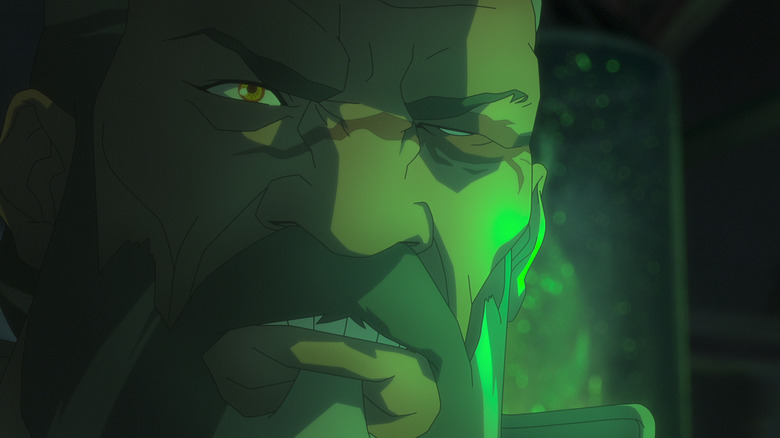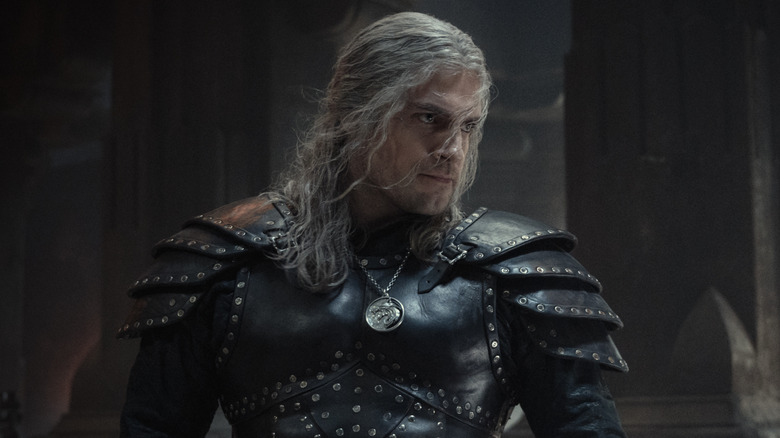12 Witcher Stories Netflix Should Tell After Blood Origin
To borrow a line from another famous fantasy franchise, Netflix's "The Witcher" and its supporting series stand upon the edge of a knife. If they stray but a little, they will fail, to the ruin of all. On the one hand, "The Witcher" is a tremendously popular, and therefore valuable, IP, with a lot of preexisting fans from the Andrzej Sapkowski novels and CD Projekt Red video games. On the other hand, once news broke that series lead Henry Cavill would no longer be playing Geralt of Rivia, fans began to proclaim the adaptation a sinking ship and, consequently, flee like rats. This puts Netflix and the various Witcher creative teams in a tricky position, and their next decisions regarding the franchise's future may be their most important ever.
Luckily for them, the world of "The Witcher" is a perfectly paradoxical setting made from equal parts rich stories from which to draw inspiration and ambiguous, unexplored aspects upon which to expand. There are thousands of years of Witcher lore, stocked with all manner of exotic locales, monsters, and characters, which — if selected and adapted carefully — can provide future Witcher projects at Netflix the impulse they need to turn fan outrage into dedication.
To help Netflix and the crew behind "The Witcher" find their way on the Path, here are 12 stories Netflix should tell after "The Witcher: Blood Origin."
Geralt and Regis
For many fans, the ideal Geralt for any future Netflix project is Cavill, but whether some djinn grants them that miracle or Cavill is indeed replaced by Liam Hemsworth, there are still Geralt tales that deserve telling. One such story is the Witcher's unexpected but meaningful friendship with Regis. When Geralt first encounters Regis in the novel "Baptism of Fire," he seems a practiced but unassuming alchemist and surgeon. It's only when his true identity is revealed — as an exceptionally rare and exceptionally powerful Higher Vampire – that his relationship with the Witcher begins to bear its best fruit (we'll assume it's blood orange).
Geralt and Regis travel together on and off throughout three books, often as part of a band that includes other fan favorites like Zoltan, Dandelion (Jaskier's name in the novels), and Milva. Along the way, the pair developed a truly deep bond, a rare thing for the stoic Witcher, which led to many of the books' most entertaining and impactful conversations. The overarching theme of the Witcher franchise has always been about the permeable boundary between monster and man, and that makes the close friendship between erstwhile mortal enemies. Both Geralt and Regis have an approximately equal claim to the titles of monster and man, making their adventures compelling and worth retelling.
The other Witcher schools
Despite the wealth of novels, video games, and comics set in and around the continent, the setting for most of the Witcher universe stories, there is painfully little written about the orders that create and train new Witchers, known as Witcher schools. Casual fans may not be aware that more than one location trains Witchers, as "The Witcher," "The Witcher: Nightmare of the Wolf," and other popular stories feature solely the keep at Kaer Morhen, the home of Geralt, Vesemir, and the rest of the School of the Wolf — hence that sizable lupine bling sported by the Witchers there. There are other schools, however, and their unique takes on what makes a Witcher would also make for a fun series or 10.
"The Witcher 2: Assassins of Kings" features a memorable series of encounters between Geralt and a Witcher from the School of the Viper (Letho, who we'll talk about a bit more later), and "The Witcher 3: Wild Hunt" a member of the School of the Cat. However, other than that, the various schools — also including the Griffin, Bear, Manticore, and Crane — are mostly a mystery. We do know the schools teach Witchers differently and even live by different codes (for example, the School of the Viper condones contract slayings of humans, while the School of the Wolf forbids it) which makes learning how the other monster hunters out there all differ a rich, fun prospect.
The Witcher: Ronin
If you haven't seen "Star Wars: Visions," you are sorely missing out. Disney+ gambled that a collection of "Star Wars" stories, all animated and almost all by different studios with different styles, would land with audiences. Land it did, as "Star Wars: Visions" found its way into a vast array of lists regarding the year's best animation, quickly earning a follow-up season. Like "Star Wars," the world of the Witcher is perfectly suited for an anthology series — even in a similar anime style. They even have the perfect source material upon which to draw in the Dark Horse Comics manga, "The Witcher: Ronin."
The manga follows Geralt in an alternate timeline, this one less like medieval Poland and more like Edo period Japan. It is heavily stylized, only using color sparingly and dramatically while sharing a lot of its aesthetics with the first of the "Star Wars: Visions" shorts, "The Duel," which also takes place in an alternate, feudal Japan-inspired timeline and also stars a silent, stoic ronin.
The story in "Ronin" is classic Witcher — Geralt moves from village to village in his long search for Ciri, along the way becoming entangled in local politics and encountering a series of creatively-designed monsters. Yet the manga stands out because Geralt's already samurai-like persona and career may actually fit the Japanese setting just as well as the original one.
The continent before the elves
"The Witcher: Blood Origin" certainly included some fun details and Easter eggs, as well as some genuinely good riffs on the central themes of "The Witcher." One of the best among them was the depiction of the elven kingdoms and the implied brutality by which they conquered the continent from the other Elder Races — the gnomes and dwarves. The storyline is particularly interesting in that it paints the eventual persecution of the elves by humans in a more tragic, yet ironic, way. The crusade against elves (among others) that forms the backdrop of "The Witcher 3: Wild Hunt" and other stories of that age feels different now that we've seen a glimpse of the elves doing the same to their predecessors. That makes it particularly interesting to see the cycle turn backward by showing the continent before the elven diaspora.
Any story within the universe of "The Witcher" that includes a cast free of humans and elves alike would again shed light on the core Witcher theme of dubious victimization and morality — as well as whether the Elder Races truly ran a peaceful Eden or not. There is also the added draw of seeing the beloved dwarven race on screen en masse, an opportunity wasted by films like "Warcraft" and a solid five out of six "The Lord of the Rings" movies.
The missing 1,200 years
At the end of "The Witcher: Blood Origin," a lot has changed on the continent. Avallac'h has seemingly cracked the secret to time travel, an elf is mutated to become a proto-Witcher, and — more important than anything else — the Conjunction of the Spheres smash an untold number of worlds together, bringing with it humans and a vast array of monster species. Since "The Witcher" is set after monsters have become scarce and Witchers struggle to find work, and "The Witcher: Blood Origin" is set just before and as monsters infest the continent, that leaves the golden age of the war between Witchers and monsters untold. This is a beyond-exciting prospect for fans of the setting.
In the 1,200 years between the Conjunction and Geralt's heyday, the continent is wracked by a war that spans every nation, one disastrous enough to cause ordinary folk to turn to cat-eyed, mutated Witchers for salvation. In order for otherwise-superstitious peasants to turn to Witchers — in their eyes, the lesser of two evils — the first monsters must have been terrifying and numerous. Fans would want nothing more than to see every manner of silver sword-wielding Witcher try to slay them, and future stories in "The Witcher: Blood Origin" could do just that.
Geralt and Letho
Anyone who has played "The Witcher 2: Assassins of Kings" will know the name Letho of Gulet, the Witcher from the School of the Viper who brutally and definitively earned his infamous nickname, the Kingslayer. Letho and Geralt meet as friends and fellow Witchers on the Path but become mortal enemies. However, it's clear that the two are strikingly similar. Unlike the vast majority of warriors Geralt encounters throughout his long life, Letho is actually his equal in combat, and the converse is true, too. Whether as friends or foes, Geralt and Letho seem almost destined to meet, and hopefully they will again on Netflix.
If the value in a Geralt and Regis team-up is in the unexpected friendship between a monster and a monster slayer, the value in a Geralt and Letho team-up is the unexpected rivalry between two fellow monster slayers. Despite their shared trauma (such as a childhood in Witcher training) as well as life goals, Letho and Geralt ultimately reach a mutual kill-or-be-killed situation after Letho assassinates two of the Northern Kingdoms' kings, Demavend III of Aedirn and Foltest of Temeria. Importantly, given the freedom of choice offered in "The Witcher 2: Assassins of Kings," Geralt had the option to spare Letho, leaving room for his return in "The Witcher 3: Wild Hunt" and, hopefully, streaming services.
The fables of far-off nations
Andrzej Sapkowski's "The Witcher" novels and short-story collections see a young Ciri taken to the far reaches of the continent and even different worlds as she flees from pursuing Nilfgaardians, Northern kings and queens, sorcerers, hired thugs, elves, and seemingly everyone else with a pulse. In the process, we get a taste of some of the diversity of Sapkowski's worlds, including far-off countries and alien cultures, but only rarely through anyone's eyes except for Ciri's — and rarely for long. There is an abundance of content to explore outside the homogeneous Medieval Europe analog that is the Northern Kingdoms, and Netflix would do well to make the journey.
Netflix needn't look any further than the official Witcher subreddit, r/Witcher, for inspiration. Over the years, the community has posted about their favorite locations repeatedly, the most common being the Viking Age-inspired island chain of Skellige and the French/Spanish chivalric utopia of Toussaint. The former is a harsh land of Viking Berserkers and ghost ships adorned with Celtic and Norse art. The latter is like the dream of Don Quixote come to life, full of windmills just ready to be mistaken for giants, actual giants, and gorgeous rolling hills replete with wineries and orchards.
Both are highlights in the novels and games which would surely freshen up the creative juices at Netflix.
Curse of Crows
Of the many graphic novels published by Dark Horse in "The Witcher" universe, one stands out for its unique position within the franchise's complex canon. The story is "Curse of Crows," and a big part of what makes it special is how it connects the canon of the novels, video games, and (obviously) graphic novels — that and its excellent storytelling.
The story makes the bold choice to set itself after the video game trilogy — which is famous for its player decisions that lead to multiple different endings — and establishes one set of decisions as the canon set for Geralt. In this new canon, Ciri does indeed become a Witcher and follow Geralt on the Path, and — with apologies to all Triss fans — chooses Yennefer as his main squeeze. That alone simplifies the ambiguous timeline, but "Curse of Crows" also pairs its main story with a flashback sequence featuring a young Geralt in his famous battle against the striga from the very first novel, "The Last Wish."
While the modern Geralt sports the iconic combination of beard, updo, and armor set from the video games, the young, flashback Geralt looks the way Sapkowski described him all those years ago — beardless, with his long hair down, and wearing only the lightest leather jerkin. It's a treat to see the two eras and styles joined together, and joining the Netflix series alongside them would be an even bigger treat.
The Bloody Baron
With so many of Geralt's adventures presented in so many different media, it can be tough for any one story to stand out. Yet, according to fans on Reddit, the storyline in "The Witcher 3: Wild Hunt" surrounding the Bloody Baron and the Crones of Crookback Bog may just be a clear winner.
You'd be hard-pressed to find a story arc with more bittersweet moments and poignancy than the tale of the Bloody Baron, his estranged daughter, his mentally-ill wife, and the unborn child that becomes an undead monster known as a botchling. Like all the very best stories in "The Witcher," the Baron's tale takes a cold, hard, penetrating look at where the lines are drawn — and redrawn — between good and evil, right and wrong, and even love and hate.
At every point in the long, emotionally-rich saga in which the player thinks they have a firm patch of moral ground to stand on, the game's writers unleash a landslide of discomfort, dubiousness, and death. By the end of Geralt's encounters with the Baron and his family, players' choices have the potential to result in the death of an entire town, a group of innocent orphans, the Baron's wife, the Baron's unborn child, and the Baron himself. There's also the looming threat of unleashing an ancient, evil deity back into the world. It's impossible to prevent all of these, and this leaves players in a challenging — but unforgettable — position.
The Conjunction of the Cyberpunks
One brief conversation between Ciri and Geralt in "The Witcher 3: Wild Hunt" sparked a wave of fan interest and theorizing for one very meaningful reason. During their chat, Ciri tells Geralt about another world, one that not only seems to be millennia in the future but specifically in the world of CD Projekt Red's other major game release, "Cyberpunk 2077." This opens up one massive, gritty, neon-lit door for Netflix.
Admittedly, it's a longshot by any measure to expect Netflix to place Freya Allan's Ciri in a story where she travels to the distant future, especially to the specific future of another IP, but there is almost no doubt that the project would be a major draw. One of the best bits of world-building Sapkowski did in his books was use Ciri's erratic teleportation magic to show us vague hints of far-off lands and strange, new worlds. Netflix would be foolish to completely ignore the tremendous potential in exploring those worlds, especially if it involves combining fandoms from their previously-established hit series, "The Witcher" and "Cyberpunk: Edgerunners."
The real first Witcher
It was a perfectly fine idea for "The Witcher: Blood Origin" to explore the creation of the first-ever Witcher, but the series' ending makes it clear that this was just a proto-Witcher, a beta test before the more expert transformations to come. From a storytelling standpoint, the choice not to show the first true Witcher is dubious, but from a business standpoint, all that matters is that it leaves a potentially excellent story untold — a promise that Netflix can still pay off.
The quasi-Witcher in "Blood Origin" is the elf warrior Fjall, who is given a mixture of flowers and roots and then transfused with the blood of a giant, monstrous centipede. Eventually, Fjall's mutations overtake him, leaving him a hideous, ogre-like creature with little self-control, forcing his companions to mercy kill him. Whether you enjoy that story or not, there is no arguing that it is a far cry from the skilled, knowledgeable, deadly monster trackers we're familiar with as Witchers.
Between the grotesque Fjall and the next Witcher-earliest Witcher we meet in the Netflix universe, Vesemir's mentor Deglan, there are around 1,100 years and plenty of stories about early Witchers that deserve an explanation.
A tale of two Witchers
More than any other story, the one that is most likely to mark either triumph or ruin for "The Witcher" on Netflix is the farewell to Cavill's Geralt and the introduction of Hemsworth's. In all likelihood, the passing of the torch will be split between two separate occasions, with Cavill exiting after the Season 3 finale and Hemsworth entering in the Season 4 premiere. However, if Netflix, Hemsworth, and most importantly Cavill, are willing, they can bring the two Witchers together onscreen and make that torch-passing more literal.
Naturally, any attempt to bring the two Geralts together that seems even remotely contrived or ham-handed is as likely to anger fans as it is to entertain them, but if done right, the story could be a hit. Even more importantly, it could signal a genuinely amicable relationship between Cavill and the franchise going forward.
There are any number of Doctor-Whovian plots that could place the two together — failed mutation experiment, secondary mutation (a la Beast from "The X-Men," for example), or even a portal accident (which, in a fun Easter egg, would prove Geralt's well-documented disdain for the magic true). Regardless of the how, the why is an important consideration for Netflix and the creatives behind "The Witcher." Is replacing Cavill without one iota of canonical reason the right choice, or should diehard fan support be the new metric by which they plan future tales from the world of "The Witcher"?
